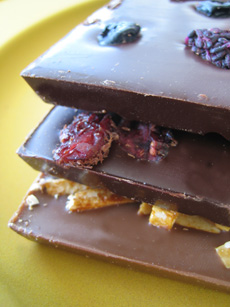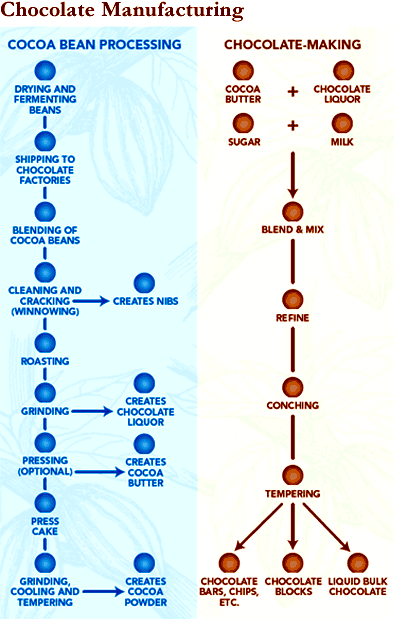 
Artisanal bars from Michael Mischer Chocolates of Oakland, California. Photo by Melody Lan | THE NIBBLE.
|
KAREN HOCHMAN’s first word was not cacahuatl...but as her mother will attest, it was pretty close.
|
|
May 2006
Updated January 2009
|
 |
From Pod to Palate Part II: The Birth Of The Bar
Page 1: Introduction To How Chocolate Is Made
You’ll never look at a simple chocolate bar again after you read this article. There are 15 arduous steps from growing the beans to getting that bar packaged and ready for sale. At any step in the process, it’s easy for something to go wrong. This is Page 1 of ten pages of fascinating information about how that delicious chocolate bar is produced. Click on the black links below to visit other pages.
Introduction
Unlike grinding a roasted coffee bean and brewing it into a cup of coffee, there’s a lot that goes into making a chocolate bar. It can take five days of work from the time the bean arrives at the production facility until the average chocolate bar is ready for your consumption. Valrhona spends five days just conching its grand cru chocolates, eliminating the impurities and creating a silky-smooth mouthfeel.
In the chocolate manufacturing process, chocolate liquor is mixed with cocoa butter and sugar to create a bar. In the case of milk chocolate, fresh, sweetened condensed or powdered whole milk is added, depending on the individual manufacturer’s formula and manufacturing methods. That’s the short story, but there are more than a dozen steps to actually making that bar, whether it is an eating bar, like the beautiful artisan bars in the photo at the left, or couverture, the professional blocks that are melted down by chocolatiers to make the artisan bars, filled chocolates, enrobed chocolates and truffles.
This article will take you through that process, and will introduce you to some of our favorite chocolate bars as well. To start, here’s a charted overview of the process of making chocolate, courtesy of the Chocolate Manufacturers Association. We’ll bring it to life the two major phases—growing and processing the cacao* bean and making the ground nibs into chocolate—with words and photos.
*While Americans say “cocoa bean” instead of “cacao bean,” that tradition came from a misspelling on a ship’s manifest in the 17th century. We prefer the correct international term, cacao, after the name of the plant, Theobroma cacao. We believe that “cocoa” should be reserved for referring to cocoa powder, which is used to make the beverage cocoa, among other things.

Continue To Page 2: Growing The Cacao Beans
Go To The Article Index Above

|





